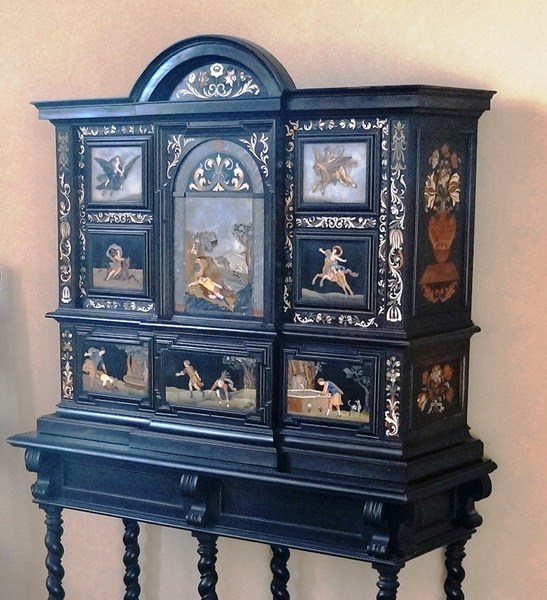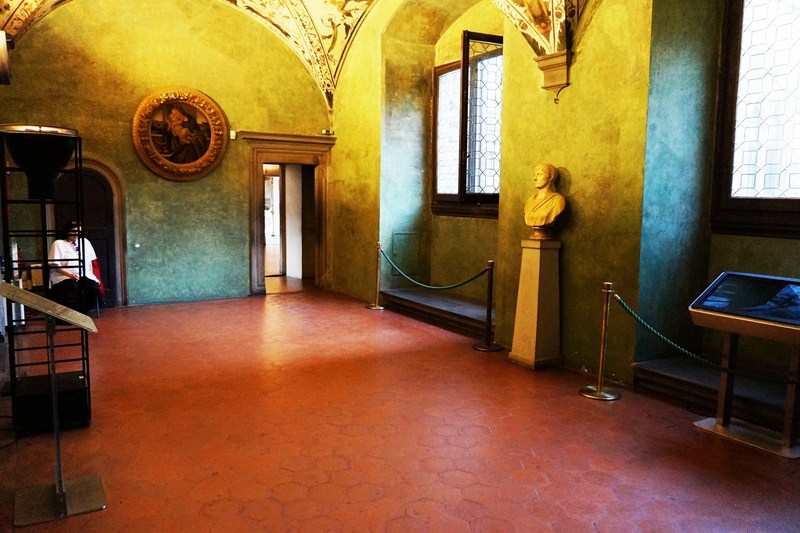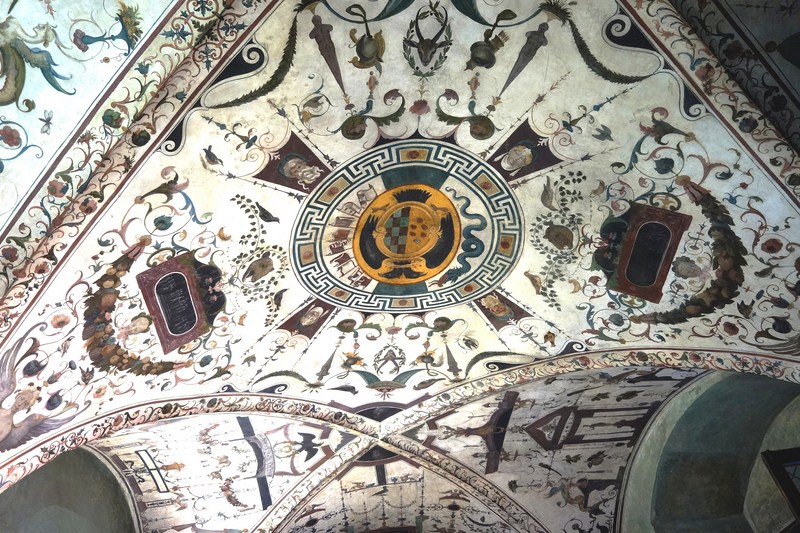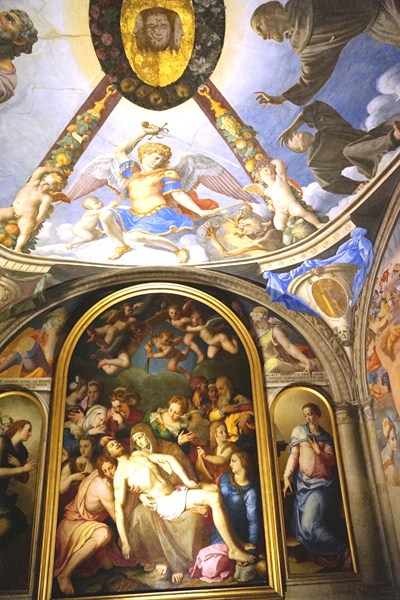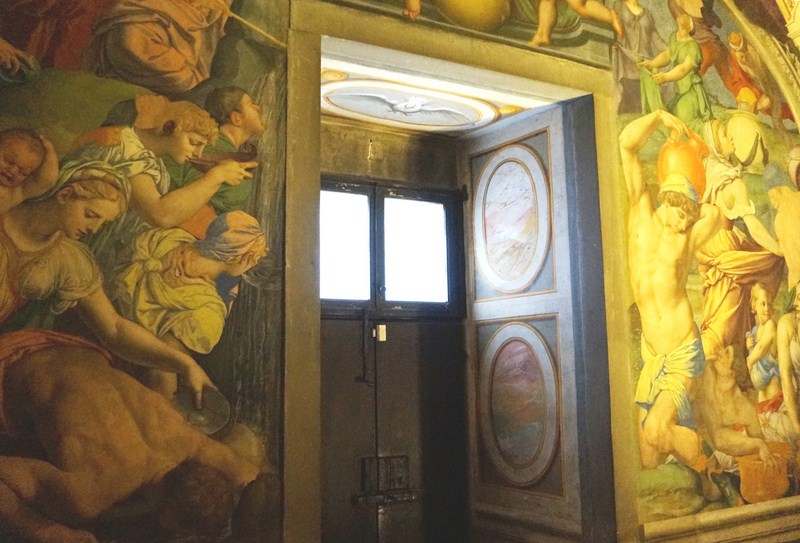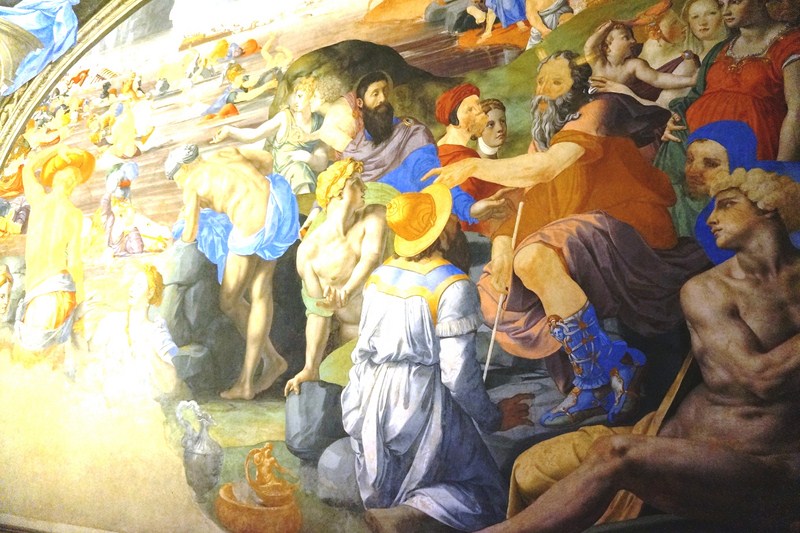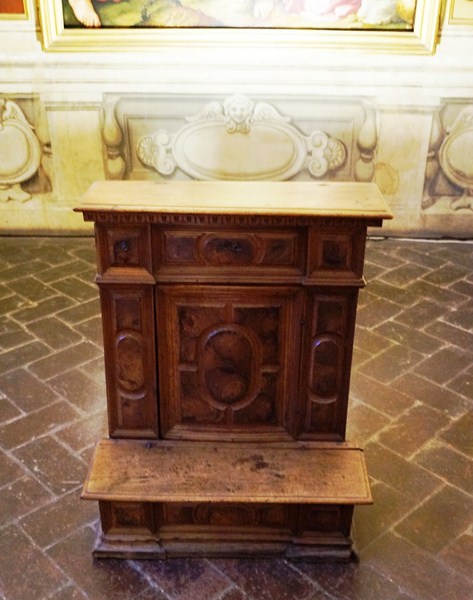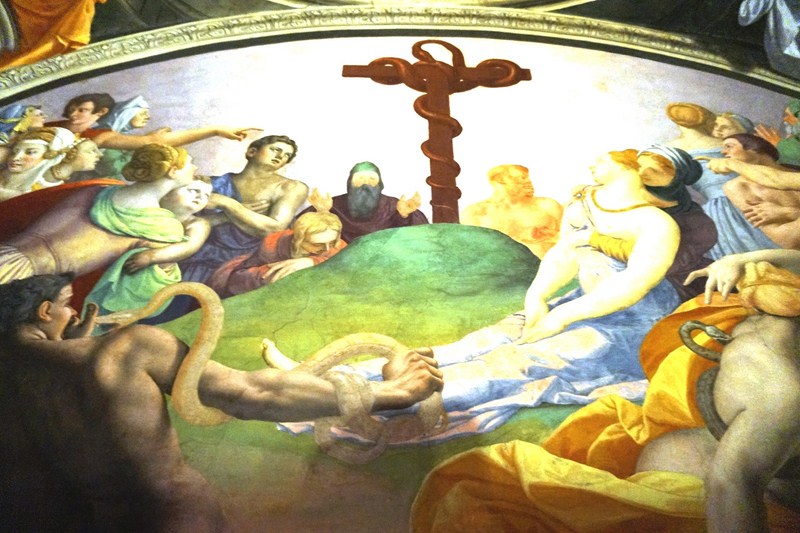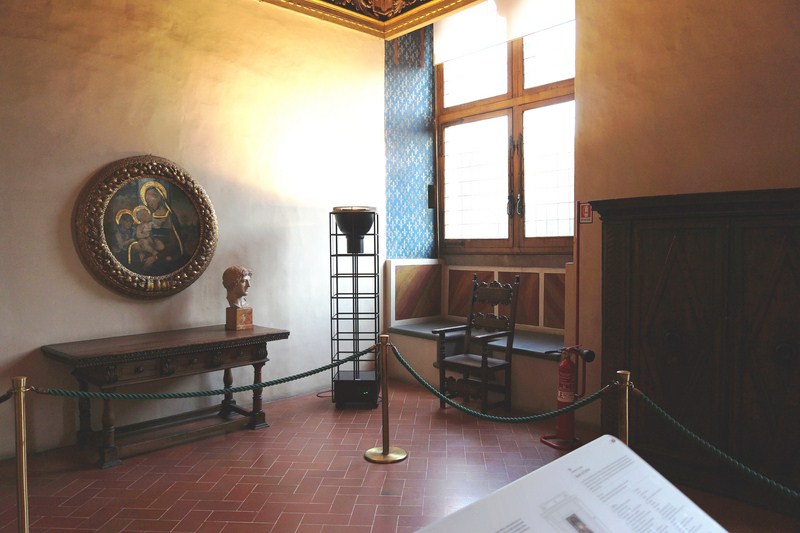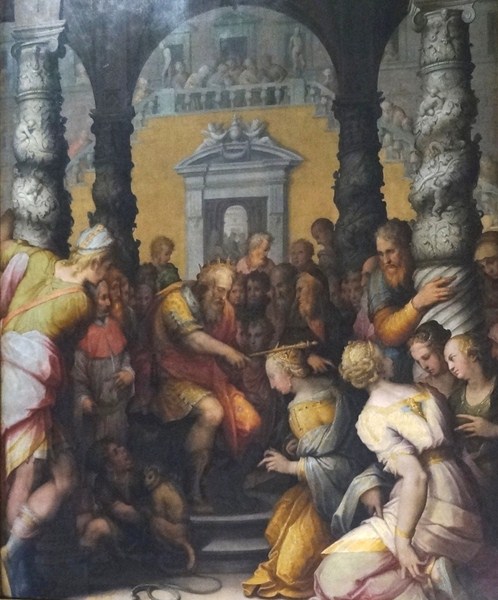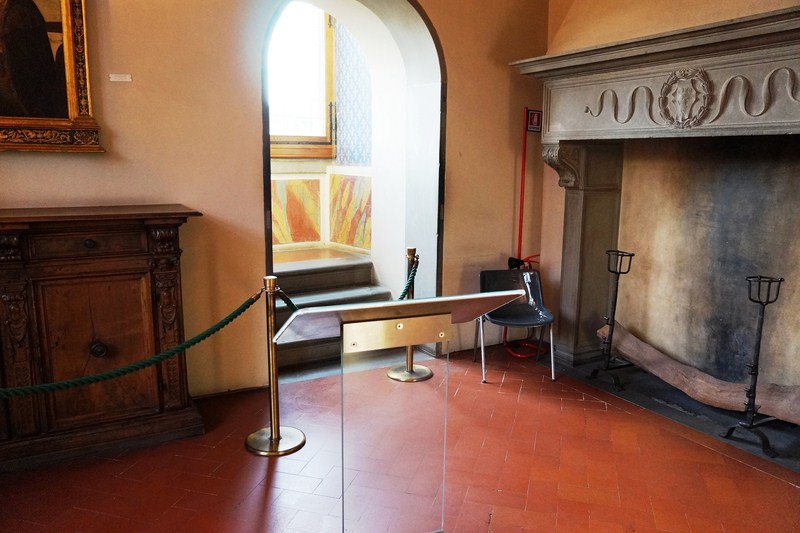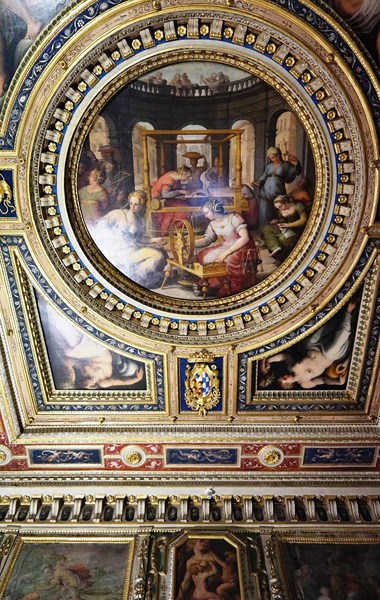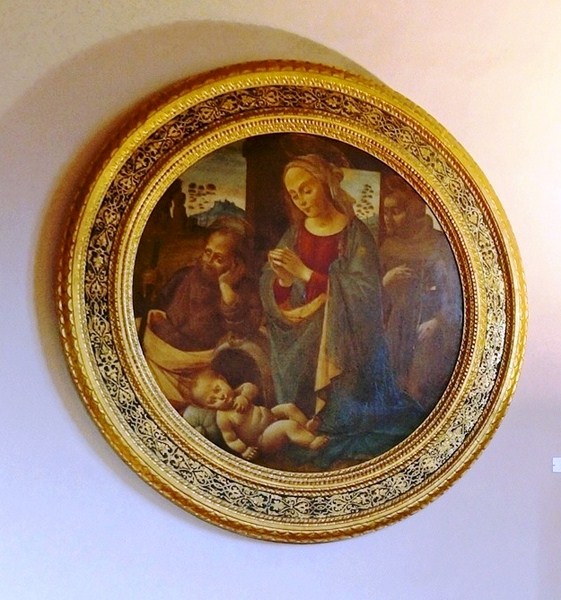The Apartments of Eleonora, part of the original core of the building, was erected between the late 13th and mid-14th centuries. For two centuries, they housed the private apartments of the members of the medieval city government, the Guild Priors and the Gonfalonier of Justice, who resided in isolation in the palace for the duration of their mandate.
Check out “Palazzo Vecchio“

Room of Esther. On the upper right is a copy of the oil on panel painting “Battle of Anghiari” done by an unknown artist (after Leonardo da Vinci, 1505-1563?). It is on permanent loan from the State Art Galleries of Florence (1930)
In 1540, when Duke Cosimo I de’ Medici moved his court into the palace, he assigned these apartments to his wife Eleonora di Toledo (the daughter of Don Pedro de Toledo, viceroy of Naples) whom he had married the year before. All the members of the duke’s family had their private rooms in this wing of the building. Cosimo’s rooms were on the first floor while the children’s rooms were located above Eleonora’s apartments.
Under the direction of Battista del Tasso, work began at once on converting the apartments into the duchess’s private rooms and it included the construction of the famous private chapel frescoed by Agnolo di Cosimo (known as Agnolo Bronzino). From 1561 to 1562, building continued under the artist Giorgio Vasari and his assistants, raising almost all the ceilings and decorating them in honor of Eleonora di Toledo with stories of classical heroines celebrated for “equalling men’s virtue,” when not actually surpassing it. The duchess lived barely long enough to see the work completed, dying of malaria in December 1562. The oil on wood paintings are by Giorgio Vasari and Giovanni Stradano while the gilded stucco and wood frames are by Battista Botticelli.
The Green Room (Sala Verde), so-called because of the now lost (they have been replaced by a standard green hue) landscape paintings that once adorned its walls, was the first in a series of rooms which Duke Cosimo I de’ Medici decided to restructure when he moved into the palazzo. However, the grotesque decoration in the vault, based on Classical models and remarkable for the presence of numerous parrots and other species of birds, has survived. The room is thought to have originally resembled a kind of trompe l’oeil loggia.
Built between 1539 and 1540, it has decorations on the ceiling and walls by Ridolfo del Ghirlandaio (1540-1542), the painter responsible for decorating the Chapel of the Priors in the Palazzo some 30 years earlier.
Check out “Palazzo Vecchio – Apartments of the Priors“
Set into the long wall of the Green Room is Eleonora’s Study, a small room thought have been used as a study or writing room. After he had finished decorating in fresco the walls of the Audience Chamber in the adjacent Apartments of the Priors, Francesco Salviati decorated the ceiling with grotesque work and with small mythological scenes of Roman inspiration (ca. 1545-1548).
The Private Chamber of Eleanora was one of the private rooms of Eleonora of Toledo, wife of Cosimo I de’ Medici. The paintings are by the Flemish painter Jan Stradan (better known under his Italian name Giovanni Stradano) while against the wall is a cabinet with Florentine mosaic designs. Originally called the “Room of Gualdrada,” the ceiling painting depicts Gualdrada refusing to kiss Emperor Otto IV, an episode that extols the virtues of purity and modesty.
According to tradition, Gualdrada, a beautiful Florentine girl who lived in the 12th century and whom Dante mentions in the Divine Comedy, disobeyed her father’s command to allow Emperor Otto IV, who was visiting Florence, to kiss her. She objected that she would only allow her future husband to do so.
The ceiling painting is also an allegory that alludes to the independence of the city of Florence. The bond between Gualdrada and Florence is highlighted by the decoration in the frieze showing views of the city and its traditional festivities.
The adjoining, richly decorated private chapel of the Duchess Eleonora of Toledo, on the right, was built by walling off the first bay of an existing room (1539-1540). It was frescoed by Mannerist Agnolo Bronzino at intervals between 1540 and 1565.
One of the loftiest masterpieces of Florentine Mannerism, it celebrates the Medici dynasty in a complex iconographical program built around the Eucharist (in other words, Christ who died to save mankind). The frescoes in the vault refer to the Apocalypse.
Another of Bronzino’s other masterpieces included Crossing the Red Sea. The room’s small door indicates the beginning of the Vasari corridor, a passageway to the Palazzo Pitti built by Vasari for Cosimo I.
The dialogue between the altarpiece, with its Deposition, and the three walls, with their stories of Moses, presaging Christ’s sacrifice and the mystery of the Eucharist, points to the link between the Old and New Testaments. Over time (1545-1564), Agnolo Bronzino himself changed the three oil-on-panel paintings on the back wall with a large Pietà.
The present Deposition replaced an earlier, almost identical version which Cosimo gave to Emperor Charles V’s secretary (Besançon, Musée des Beaux-Arts); the panels with the Annunciation replaced a St John the Baptist (Los Angeles, J. Paul Getty Museum) and a St Cosmas (fragment in a private collection).
The ceiling frescoes features a head with three faces (symbolizing the Holy Trinity), St Michael the Archangel defeating the Devil, St John the Evangelist, St Jerome Penitent, St Francis receiving the stigmata, and the Cardinal virtues.
The Room of the Sabines, so named because of the ceiling decoration was, at one time, used for the ladies-in-waiting at the court of Eleonora di Toledo. It contains Portraits of Medici Princes (a painting by Justus Sustermans), statues by a Florentine art school and a tapestry by Fevère.
Latin historian Livy tells us that, after founding Rome, King Romulus deceitfully abducted the womenfolk of the neighboring Sabine tribes and brought them to his new city. The Sabines declared war on Rome, but their women, led by Ersilia (who had married Romulus), averted the clash between the two peoples by entering the fray and calling for peace.
The episode, depicted in the center of the ceiling, celebrates the womanly virtue of mediation and features the Sabine women making peace between their own people and the Romans.
The Room of Esther celebrates Eleonora of Toledo in her role as duchess. It’s ceiling depicts Esther begging Ahasuerus to halt the massacre of the Jews.
According to the Biblical book of Esther, after he repudiated Vashti, Persian King Ahasuerus chose Esther, a young Jewish girl of rare beauty, for his wife. On the advice of his aide Haman, Ahasuerus ordered the Jews’ destruction, unaware that his new wife was a Jewess. By interceding with her husband, Esther saved her people. The decoration of the room
The Dining Room, containing a lavabo and two tapestries by Van Assel representing Spring and Autumn, has a ceiling with the Coronation of Esther, decorated by Stradano, with an inscription in honor of Eleonora di Toledo.
The Room of Penelope has a ceiling depicting Penelope at the Loom surrounded by River Gods in the center, celebrating marital fidelity and extolling the role of the woman who attends to matters at home while her husband is away at war.
In the Odyssey, the poet Homer tells us that during the long voyage of Ulysses (also called Odysseus), king of Ithaca, his wife Penelope managed to avoid remarrying by postponing her choice of suitor until she had finished a piece of cloth which she wove during the day and secretly unraveled at night.
The frieze shows the adventures of Ulysses on his way home from the Trojan War, listed here in the order in which Homer tells them. The Madonna and Child and a Madonna and Child with St. John by Botticelli are on the walls.
Apartments of Eleonora: Palazzo Vecchio, Piazza della Signoria, Florence, Italy. Tel: +39 055 276 8325. Open daily, 9 AM – 7 PM (except Thursdays, 9 AM – 2 PM). Admission: €6.00. Combined ticket with Cappella Brancacci: €8.00.


